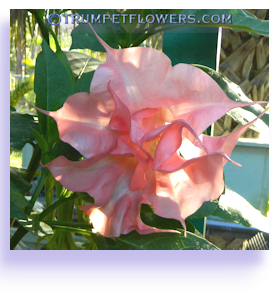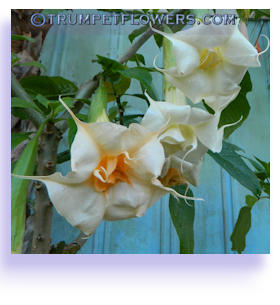Care and Grow
Shrimp Plant
Pronunciation: juss-TISH-ee-uh
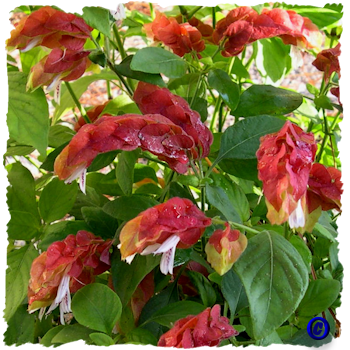 The Acanthaceae family contain such a beautiful genus of plants, it's no wonder that they are as popular amongst gardeners as they are. From showy, brillant pinks and reds to lime green and yellow shades, justicias are noted for their unusual shaped 'flowers' that are actually conical shaped and colored leaf brackets that then contain a long, usually tiny flower.
The Acanthaceae family contain such a beautiful genus of plants, it's no wonder that they are as popular amongst gardeners as they are. From showy, brillant pinks and reds to lime green and yellow shades, justicias are noted for their unusual shaped 'flowers' that are actually conical shaped and colored leaf brackets that then contain a long, usually tiny flower.
My own experience with justicia began with one of the more common cultivars, known as 'shrimp plant.' Since acquiring this one, I've made it a point to add several new cultivars to my garden. Bees and butterflies love them, especially the swallowtails and Florida's state butterfly, the zebra longwing. Since I grow many plants specifically for butterflying, I find this a plus indeed.
In my experience, most cultivars are fairly easy to grow, prefer shadier spots in the garden, and tend to get leggy if given too much shade. A longtime bloomer where I live, you can expect blooms almost year∼round with the shrimp types, such as the Justicia brandegeanas, which include the pink shrimp, red shrimp, and the fruit cocktail shrimp plants. Fruit cocktail justicia brandgeana is very unusual, having that lime green 'flower' color.
If you are lucky enough to come across this plant, do yourself a favor and purchase it. Cuttings from a friend will work with most of the justicia genus too, which I will get to later. Whatever way you obtain them, their strange flower form is attractive and does well indoors as well as outdoors, given the proper agricultural zones for each. As an example, my shrimps have easily survived temperatures of 27°, when we had a freak hard freeze a few years back. They did not even wilt nor lose their leaves or flowers!
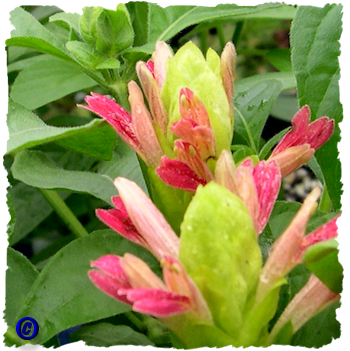 The Red and Yellow Shrimp plants do very well in a sandy, loamy soil that has added compost and peat. If planting out in the garden, you can choose a spot that gets morning sun, dappled afternoon sun, or no afternoon sun at all. In the latter case, they will tend to grow leggy, but pruning hard will bush them back up, and within 4 to 6 weeks, they will be forming flowers again. If you do choose a site with more afternoon sun, the plant will tend to stay more compact, but will still need (less often) trimming to stay tight in shape.
The Red and Yellow Shrimp plants do very well in a sandy, loamy soil that has added compost and peat. If planting out in the garden, you can choose a spot that gets morning sun, dappled afternoon sun, or no afternoon sun at all. In the latter case, they will tend to grow leggy, but pruning hard will bush them back up, and within 4 to 6 weeks, they will be forming flowers again. If you do choose a site with more afternoon sun, the plant will tend to stay more compact, but will still need (less often) trimming to stay tight in shape.
Shrimp plants can lose their leaves for several different reasons. Most often, it is either too much or not enough water. Try balancing out the watering situation, doing so only when the soil is dry on the surface inch or so. Then water very deeply, to make sure the roots are flooded well for that watering period. This should help. If it is not their growing season (spring and summer) it might be that cooler temperatures have caused a temporary loss of leaves. These should return quickly, as in the same case of over or under watering.
Justicia grows well with a good, long watering 2 to 3 times a week. Allow the first inch or so of soil to slightly dry before watering them again. Also fertilize them in spring, using half of a 'fruit and nut fertilizer spike.' Give them the other half of the spike in summer. Since an established plant can grow to a healhty bush size of 3 to 4 feet wide and the same in height, give it the whole spike the following year.
Every spring and right after you've inserted the fert spike, pull any wayward weeds that tried to entangle themselves within the plant, and gently spread about half of a large bag of good compost at their base, spreading it out with your hands. Then water it well.
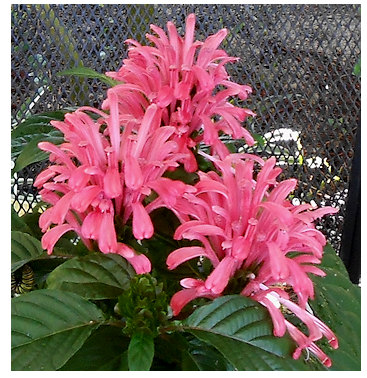 Propagating shrimp plant cultivars of justicia is relatively easy. Simply take some of the leggier stalks that you have snipped cleanly at the nodes, dip the cut tips in a rooting hormone and place them in either a gro∼cube or some prepared ground peat mixed with vermiculiteand perlite. Keep moist but not soggy for about 4 weeks, and you should see new growth. Continue to allow them to grow in the same small pot or cube until you can see roots out of the bottom of the pots, this way you know they are well established and will be able to handle transplanting.
Propagating shrimp plant cultivars of justicia is relatively easy. Simply take some of the leggier stalks that you have snipped cleanly at the nodes, dip the cut tips in a rooting hormone and place them in either a gro∼cube or some prepared ground peat mixed with vermiculiteand perlite. Keep moist but not soggy for about 4 weeks, and you should see new growth. Continue to allow them to grow in the same small pot or cube until you can see roots out of the bottom of the pots, this way you know they are well established and will be able to handle transplanting.
A few more tips when starting your new transplants...remember to pinch off any flower buds first, so the cuttings will not have to try and support them and grow a new root system, and using Actinovate and superthrive in a spray bottle and misting the cuttings with it a few times a week will also encourage stronger, faster, and fungal∼free growth.
Lastly, plan to take your cuttings when daytime temperature highs hover around 75° and nightime temps do not drop below 55°.
If you'd like information on the Pink Shrimp plant, justicia carnea, visit my other page, Plant spotlight August 2012, Pink Flamingo Shrimp Plant
Tags: grow shrimp plants, grow shrimp plant, justicia,, propagate shrimp plants, justicia brandgeana, Acanthaceae, propagation, care of shrimp plants, grow shrimp plant, red shrimp plant, green shrimp plant, fruit cocktail shrimp plant,

